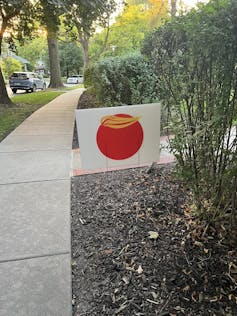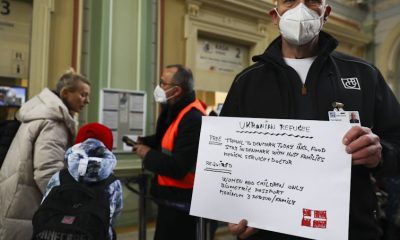
White signs emblazoned with a big blue dot are going up in yards across Omaha, Nebraska, in an unusual political statement of support for Democratic candidates.
Nebraska splits its electoral votes, giving Omaha’s congressional district a single electoral vote out of the state’s total of five. If enough of Omaha’s metropolitan voters back Democratic presidential nominee Kamala Harris for president, Omaha will appear on the electoral map as a “blue dot” on a field of Republican red.
With Harris running neck and neck with former President Donald Trump, the White House could come down to this one vote.
Power of the dot
Most U.S. states award all their electoral votes to the presidential candidate who wins the state’s election, no matter the margin of victory. Only Nebraska and Maine split their electoral votes.
Nebraska awards one vote to each congressional district, plus two votes to the state’s overall winner. It began this practice in 1992 to draw more presidential campaigns to the state. Nebraska, as a whole, so predictably leans conservative that neither Republicans nor Democrats had bothered to campaign there.
In the eight presidential elections since 1992, Omaha has turned blue only twice – in 2008 and 2020, backing Barack Obama and Joe Biden.
Democratic voters hope to buck statewide trends again in 2024.
The blue dot movement began in mid-August 2024 in Omaha’s Dundee neighborhood, when local residents Jason Brown and Ruth Huebner-Brown spray-painted a blue circle on a white sign and put it on their lawn as a conversation starter.
One sign grew to 10, 100, 1,000, snowballing into a movement. Now blue dot signs can be found well beyond Omaha, even in other states. On Facebook and Reddit, people share where to find the signs and how to make your own.
A simple blue dot on a white background has become a powerful political symbol – a reference to a map that does not have to be seen to be visualized. For Omahans in the know, the sign is a reminder of what the city’s place on the map might be come Nov. 5.
For others, the enigmatic sign simply raises questions, creating opportunities for Omahans to discuss the importance of voting in Nebraska.
Blue dot, black spot
I am a professor of geography at the University of Nebraska Omaha.
The sly way the blue dot sign refers to an election map without actually showing that map reminded me of my suffrage movement research.
In the 1910s, women activists campaigning to get American women the vote used a map as part of their campaign. It depicted U.S. states that had passed suffrage in white and the rest in black – dark marks on the nation.
The suffragists plastered their map across the country and sold it through the National Woman Suffrage Publishing Company. In newsletters and magazines, they shared how to make maps for rallies using easily accessible materials. The map became so familiar to the American public by 1912 that it was referred to in speeches and newspaper articles without the visual.
At suffrage parades and pageants they formed “living suffrage maps,” with women dressed in white representing states with the vote and those in black representing states where they could not.
As women’s suffrage momentum grew, spreading from western to eastern U.S. states, the map had ever-fewer black spots. In 1914, Nevada became the last western state to pass suffrage.
“The suffrage map showing Nevada as the last ‘black spot’ in the West was printed in every newspaper and on every leaflet,” suffragists later wrote about their efforts. It was “put up in public places and on large banners hung in the streets.”
With Nebraska’s blue dot signs, Omahans are fighting to keep their spot on the map, not erase it. They are an act of claiming space, making Democrats visible in a state so strongly associated with Republicans.
On Oct. 20, 2024, in yet another echo of the women’s suffrage movement, they even created a “human blue dot” at a rally in a local park.
A Republican red dot in Omaha.
Christina Dando, CC BY
Blue dot signs have inspired Republican countersigns.
Two I’ve seen are a white sign depicting just an entirely red Nebraska, and a white sign with a large red dot with a golden wave on its top that resembles Trump’s hair.
These red dot and red Nebraska signs are catching on, but not in the same way as blue dot signs have.
Bye-bye, blue dot?
Aware of Omaha’s sudden electoral importance, Republicans have begun trying to end Nebraska’s system of splitting its electoral votes.
In April 2024, Trump and the conservative commentator Charlie Kirk called on state legislators to propose a bill changing the state to a winner-take-all system.
Kirk described Nebraska as “being one of the most Republican states” and said the state’s electoral votes must “go towards electing the candidate the vast majority of Nebraskans prefer.”
Many people reacted with fury, and the bill did not advance in Nebraska’s one-house state Legislature. That’s another of the state’s political quirks: Nebraska is the only state to have a state legislature without an upper and lower chamber of lawmakers.
The system, called the unicameral, is officially partyless, meaning its 49 representatives are elected without their party on the ballot.
The unicameral dates from 1937 when it was thought this less costly, nonpartisan system would be a more representative form of government. So is splitting the state’s electoral votes: Voters can feel more confident that their vote counts and that every vote counts.
When South Carolina Republican U.S. Sen. Lindsey Graham visited Nebraska in September 2024, he pushed Gov. Jim Pillen, a fellow Republican, to implement a winner-take-all system for the 2024 election.
Pillen said he would not call a special session of the unicameral unless he has the 33 votes needed to pass the change to the state’s electoral system. That appears unlikely to happen before November.
Red + blue = purple?
A winner-take-all approach to Electoral College votes has the effect of erasing nuance and difference on the map of America by painting states as entirely red or blue.
No state has ever voted 100% Democrat or Republican. The country should be drawn in shades of purple.
Nebraska has the misleading appearance of overwhelming redness because of its many Republican-leaning rural counties with low population density. Yet Nebraska’s registered voters are approximately two-thirds Republicans and one-third Democrats. Many registered Democrats live in cities such as Omaha and Lincoln.
But they can be found throughout the state – just look for the blue dot.
Christina Elizabeth Dando does not work for, consult, own shares in or receive funding from any company or organization that would benefit from this article, and has disclosed no relevant affiliations beyond their academic appointment.
Advertisement

Advertisement
Contact Us
If you would like to place dofollow backlinks in our website or paid content reach out to info@qhubonews.com











